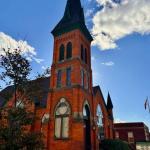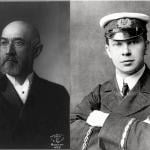Experiencing the lightness of being in Iowa
Chicago Sun-Times
December 1, 2002
FAIRFIELD, Iowa — Backstage during a production of William Shakespeare’s “A Midsummer Night’s Dream,” one of the teenage fairies sniffs homeopathic oil to soothe her head cold.
Several younger cast members chat quietly in the wings, doing yoga stretches and adjusting their platinum wigs. Oberon, the barefoot King of the Fairies, stubs his toe coming off stage, winces silently, and keeps moving.
It’s opening night at the Maharishi School in Fairfield, Iowa. Seemingly everyone in this small manufacturing town in southeastern Iowa–from the mayor to the kids flirting outside Everybody’s organic food market–has been buzzing about the play all week.
“What night are you going?”
“Have you seen the costumes?”
But backstage, there are no jitters, tantrums and general mayhem typical of high school theater productions. Everyone–from the grade-schoolers playing the youngest of the fairies to the handful of adults rounding out the cast–appears calm and collected.
Maybe it’s the meditation.
Like many other residents of Fairfield, Iowa, and its next-door neighbor, Vedic City, all of the cast members practice transcendental meditation, silent meditation based on ancient Indian writings and interpreted by Maharishi Mahesh Yogi. TM is supposed to bring profound relaxation by quieting the mind.
The Maharishi emerged in the West in the late 1950s and gained prominence in the 1960s and ’70s as a celebrity guru, with followers such as the Beatles and actress Mia Farrow.
Fairfield and tiny Vedic City–Iowa’s newest city, incorporated in July 2001–represent the TM capital of the United States.
For nearly 30 years, meditators from across the nation and overseas have found peace of mind and a place to call home in the middle of the Iowa corn belt.
But when East met Midwest in 1974, when the Maharishi–Iowans in the know pronounce it “Maharshee”–bought shuttered Parsons College, it was hardly a marriage of true minds.
The locals, many of them farmers or workers at area manufacturing plants, were leery of the meditators, interloping hippies from the East and West coasts who sat in silence at least an hour a day and who don’t eat meat or drink alcohol.
Against all odds, however, over the nearly three decades since they arrived in Iowa, the meditators have blended into the fabric of small-town Iowa.
For the most part.
“They came in with a lot of ideas,” said John Kelley, a non-meditator and superintendent of Fairfield Community Schools for the last 24 years. “They talked about controlling the stock market. . . . There’ve been articles written that they would reduce the crime rate if they meditated in a group. I didn’t believe it and I still don’t, and I don’t take any solace in the fact that they think they can do that.”
That said, Kelley insists he has a good relationship with the meditators, especially those on the faculty of Maharishi University of Management, which occupies the former Parsons campus. “Some of the professors and myself have dinner on a regular basis,” Kelley said. “There’s not the animosity that there was when they first came to town.”
Many meditators, some of them wealthy and established entrepreneurs, have set up businesses from restaurants and Internet technology to large publishing and development companies, boosting Fairfield’s sagging economy.
Jeff Wilson, publisher of the Fairfield Ledger newspaper since 1991, said most non-meditators have adopted a “live and let be” attitude toward the Maharishi’s followers who make up about a quarter of the town’s 10,000 population.
“There are certain things that bring on clashes from time to time, but from a 24-7 type of experience, there’s a benign neglect,” Wilson said. “We’ve elected a mayor who’s a meditator, and surprise, surprise, everything hasn’t come to a screeching halt.”
Twenty-eight years ago, when he was a college student in Maine, Mayor Ed Malloy, a native New Yorker, learned transcendental meditation. In 1980, he came to Fairfield to take a three-week course at the Maharishi’s university.
“I liked the area, so I decided to stay,” said Malloy, a practicing Roman Catholic and father of two who is the first meditator to be elected mayor of Fairfield.
Malloy, who runs a fuel brokerage business, served on the city council from 1992 to 2000 and ran unsuccessfully for mayor in 1997 against a longtime incumbent. Five years ago, TM was definitely a divisive issue in the campaign, he said. “That’s where a lot of the rancor in the race came from,” he said.
But when Malloy ran again in 2001 against the same opponent, he won. Two other meditators also serve on the seven-member city council.
Just over the Fairfield town line to the north is Vedic City, which is more a series of subdivisions than a city. The upscale homes are all built in the Sthapatya-Veda style, an architectural design promoted by the Maharishi that’s akin to feng shui and is based on ancient Hindu writings.
The style is not particularly Asian-inspired, except for the gold domelike knots, called dashas, on each roof. And the colorful flags with a sunburst that festoon the front of most buildings, including the swanky home of Vedic City Mayor Bob Wynne. There, weekly city council meetings are held around a big glass table, the city council members all in their stocking feet, the men inexplicably all wearing khaki suits in November.
Downtown Fairfield, with its silos and town square circled in red-white-and-blue park benches, could be anywhere in America’s heartland.
It’s subtle touches, such as several Indian restaurants on the square, shops with names such as Tranquility and Health & Wholeness, and the falafel stand on Depot Road by the train tracks, that reveal Fairfield’s alter ego.
What do stick out are two enormous domes that sit on a small ridge overlooking the rest of the campus, which also includes the K-12 Maharishi School, where plaid-uniformed students learn meditation and Sanskrit along with traditional subjects.
The Golden Domes of Pure Knowledge, one for men and one for women, draw about 1,000 advanced meditators every day. Most transcendental meditators practice twice a day for 20 minutes, once in the morning and once at night. More advanced practitioners, known as sidhis (“cities”), can spend up to three hours meditating and “yogic flying” each day.
The floor of the men’s dome is covered in foam rubber, which cushions the landing part of yogic flying. The “flying,” what practitioners explain as a “meditation’s dynamic state,” is much more like hopping than levitating.
In the dusky light of the dome, Rod Falk, 52, Ted Hirsch, 24, and David Sinton, 21, demonstrated the flying for a curious reporter. Normally, those who are not sidhis are not allowed in the domes to watch the fliers. The three men sit side by side, eyes closed in the lotus position for a few minutes. And then, they start to hop on their knees, in unison, without talking to each other.
“The first stage looks humorous,” said Falk, who has been “flying” for 25 years. He can catch some good air–maybe three feet–as he hops forward on the mats. “Muscles are involved, but it’s almost like a spontaneous thing,” he explained. “The body fills with energy and it’s filled with lightness, as well. The next thing you know …”
The “flying,” like the stationary version of transcendental meditation, brings the practitioner unbelievable bliss and clarity of mind, the men said.
Vedic City officials have grand plans to develop their subdivisions into a world-class destination and retirement spot. The focal point, however, of the Vedic City plan would bring 8,000 full-time yogic fliers in to live and work–work meaning meditate and fly–to bring about world peace. Scientific research has proven that meditation has a positive effect on reducing stress in individual people. The Maharishi, who was trained as a physicist before becoming a Hindu monk, believes that kind of stress reduction would be societal if enough people were meditating in the same place, at the same time.
Lorena Reynoso, 20, of Chicago’s Lake View neighborhood, first heard of the Maharishi’s university in Fairfield at a college fair at Navy Pier.
She was attracted to the university because, she said, she was looking for a place that understood “people in my stage of life are looking for something more.”
Raised in a devoutly religious Roman Catholic home, she was intimidated by what she might find among the meditators in Fairfield, and her family was worried.
“Coming here they thought I’d shave my head, wear a sheet and pass out flowers,” said Reynoso, a business major. “I thought the people here must be like Christs or something. I didn’t know people would have everyday problems.”
_______________________________________________________________________
VEDIC CITY AT A GLANCE
*Incorporated as Vedic City, Iowa, on July 25, 2001, the first new city in Iowa since 1982. Population: 176
*Among the city council’s first acts was to make Sanskrit the city’s “ideal” language and to change the city’s name from “Vedic City” to “Maharishi Vedic City.”
*All buildings must be built according to the rules of Vedic Architecture, all facing east with an open space in the center of the home and a gold dome on top. Residents are encouraged to drive hybrid or electric cars.
*According to the city’s master plan, it will include meditation space for 8,000 yogic fliers; a huge temple; a retirement community; an 18-hole golf course, and Maharishi Veda Land, a theme park with illusions designed by the late magician (and TM enthusiast) Doug Henning.
*This year the city began circulating brightly colored currency called Raam, in addition to U.S. currency, kind of like Club Med cash. One Raam equals $10.
_____________________________________________________________________________
Naked truth about Vedic’s body-cleansing massage
December 2, 2002
Chicago Sun-Times
VEDIC CITY, Iowa–I’ve never felt so naked in my life.
That’s all I can think at first as I sit cross-legged on a table in the treatment wing of the Raj Hotel, staring out the window at a swan in the pond out back, as two middle-age women in pink shirts, khaki ankle-length skirts and white chef’s aprons apply warm coconut oil all over my body.
There’s just a Motel 6-size white hand towel between me and total nudity, and the experience so far is really, really not sexy. It’s about as sexy as a visit to the podiatrist.
For the sake of journalistic integrity, I’m having an Ayurvedic treatment called abhyanga, which entails the two technicians–who look like they should be baking cookies–working in tandem, one on each side of my body, applying the oil for about 90 minutes.
One of the reasons people come to Vedic City is to experience some of the most skilled practitioners of Ayur Veda–an ancient system of health care from India–in the world. The Raj Hotel is kind of like the Mayo Clinic of Ayurvedic medicine, but with room service and a spa.
Clients pay about $2,000 for a weekend treatment at the Raj. The abhyanga, which is part of a longer purification process called Panchakarma, is one of the simplest things offered.
Normally, it’s preceded by several days of at-home preparations, including drinking castor oil and glasses of ghee (clarified butter) and is followed by a treatment called basti. That’s an oil enema. Now, I’m all for experiential reporting and taking one for the Chicago Sun-Times team now and again, but that last bit’s just not in my contract.
Oil massage: yes. Oil enema: no.
The abhyanga is done in total silence. No plinky-plunky massage therapy music. No “how’s your tennis game” chitchat. Just me, the two ladies and the sloshing of oil on skin.
The treatment starts with me, still wrapped (happily) in a big, white sheet, seated in a chair. The ladies kneel in front of me and gently wash my feet with warm water from a small basin between them. It tickles, but it’s kind of nice.
Next they give me a head massage, applying loads of oil to my scalp, face and ears. They massage my earlobes.
Time to lose the sheet and hop up on the large, cushioned wooden table. The ladies, working in symmetry on either side of me, apply the oil in long, even strokes along my arms, legs, and torso, with circular motions at the joints, abdomen, and, well, coccyx. They spend about five minutes massaging oil between my toes.
After I get over being so naked, it’s actually kind of relaxing. Eventually I just fall asleep.
The idea of all of this, according to Ayurvedic teachings, is to help me get rid of ama, or impurities, by gently getting the body’s systems to start working smoothly. They say it aids elimination. (Elimination is a big theme at the Raj.)
Some enthusiasts joke that abhyanga (pronounced “ah-bhyun-guh”) means, “I’ll be younger.”
After two hours of massage and a really great nap, I don’t feel younger. But I do feel less naked.















